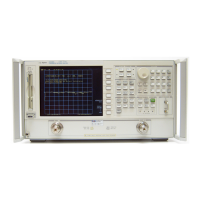Index
Index-7
S
sampler
A and B check by substitution
8-8
assembly, control bias voltages
7-9
control voltage check
7-9
signal down-conversion
description
12-14
voltage check
8-9
sampler check
8-7
SAVE FAILED.INSUFFICIENT
MEMORY
10-39
selector switch check
5-8
self diagnose softkey
10-8
SELF TEST #n FAILED
10-39
self-test
how to initiate
4-5
serial number correction
constants adjustment
3-11
service equipment
1-2
service feature menu map
10-16
service key menus
10-2
internal diagnostics
10-3
service features
10-15
service modes menu
10-17
service modes more menu
10-19
service test equipment
1-3
service, how to get analyzer
4-4
setup
fractional-N spur avoidance and
FM sideband adjustment
3-45
frequency accuracy adjustment
3-41
shipment for service
15-3
shorts, RF, recommended part
numbers
1-4
shorts, verifying
9-5
shutdown circuitry
disable of
5-15
signal separation
12-5
ES model theory
12-19
ES simplified block diagram
12-19
ET Models
12-22
Smith chart traces
9-7
source
12-5
band-related problems
7-22
broadband power problems
7-26
check
4-17
group theory
12-13
phaselock troubleshooting
7-9
step attenuator (A69) check
7-27
troubleshooting
7-2
troubleshooting flowchart
7-3
what to do if power is incorrect
at R channel
7-6
where to start troubleshooting
7-5
source linearity
performance test
2-38
test record
2-48
source match
(ESF and ESR) description
11-12
uncorrected performance
11-8
SOURCE POWER TURNED OFF,
RESET UNDER POWER
MENU
10-39
source pretune
correction constants adjustment
3-6
description
12-14
splitter
description (ES models)
12-19
recommended part numbers
1-4
spur avoidance and FM sideband
adjustment
3-44
step attenuator (A69)
check
7-27
description
12-20
steps to take if R power incorrect
7-6
stuck key table, LED patterns
6-14
subsweep frequencies
table of all models
12-16
supported system configurations
2-18
swapping IF cables
7-9
SWEEP MODE CHANGED TO
CW TIME SWEEP
10-39
SWEEP TIME TOO FAST
10-39
switch positions, A7 CPU board
6-4
switch repeatability check
4-25
system operation
12-3
theory
12-3
system verification
2-1, 2-15
equipment initialization
2-20
equipment needed
2-18
post-repair
14-35
test setup
2-20
tests
10-11
what it verifies
2-17
T
temperature and humidity
check
2-6
terminations, recommended part
numbers
1-4
TEST ABORTED
10-39
test equipment
required types
1-3, 1-4
service
1-3, 1-4
table of
1-3
test options menu
10-6
test pattern descriptions
10-13
test port coupler removal
14-30
TEST PORT OVERLOAD,
REDUCE POWER
10-39
test record, performance test
2-46
test setup
frequency accuracy
2-34
measurement calibration
2-22
power meter
2-36
system verification
2-20
test status terms
10-5
tests
adjustment description of
10-12
display description of
10-13
external descriptions
10-11
internal description of
10-8
menu
10-5
options menu
10-6
performance
2-33
system verification
10-11
test pattern description
10-13
theory
12-6
digital control
12-9
power supply
12-6
source group
12-13
system operation
12-3
transfer switch description
12-21
transmission port check
4-9
transmission tracking
description
11-16
uncorrected port performance
11-8
TROUBLE!CHECK SET-UP AND
START OVER
10-40
troubleshooting
accessories
9-2
band-related problems
7-22
broadband phaselock problems
7-8
broadband power problems
7-26
CPU (A7) board
6-4
display (A18,A19)
6-7
fan
5-18
front panel (A1/A2)
6-13
GSP (A19) and the Display(A18)
6-9
organization
4-13
phaselock by swapping IF cables
7-9
power supply flowchart
5-3
receiver signal paths
8-3

